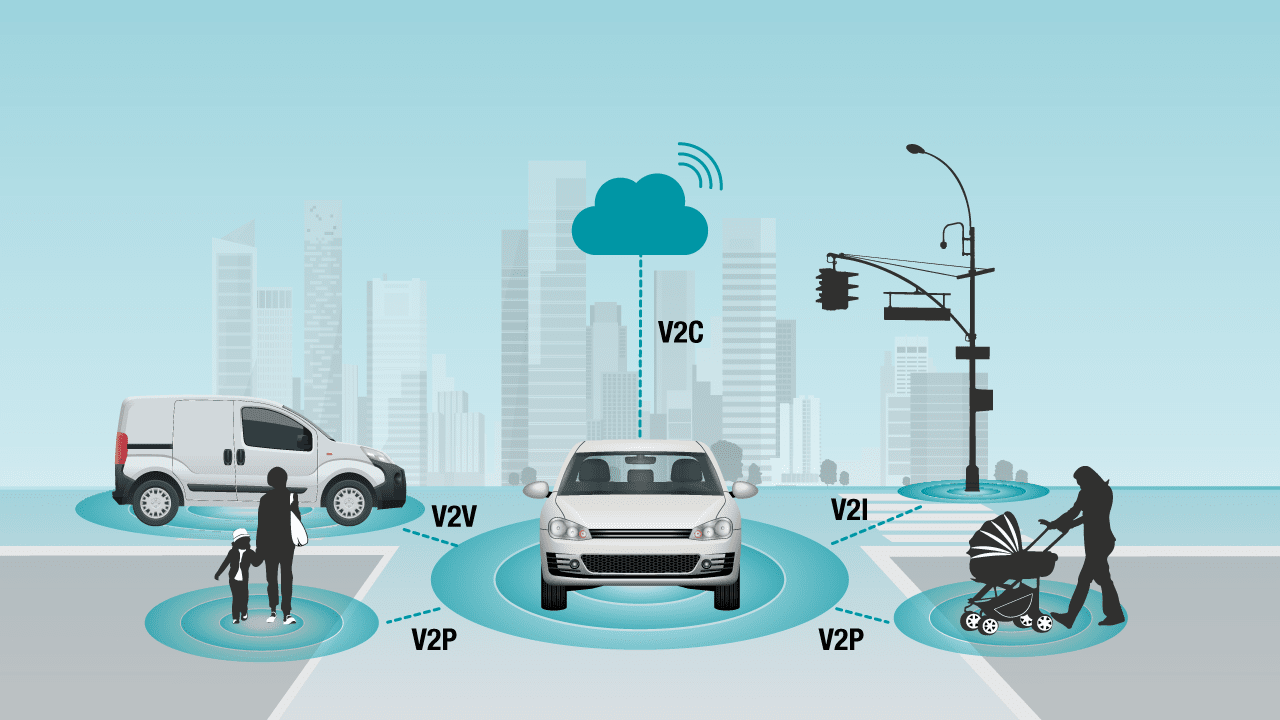SSZT418 August 2019
Connected driving, even though it exists today, still has a long way to go. In the future, vehicles will communicate with the driver, other cars, the road and surrounding infrastructure, pedestrians, and the cloud, all while giving passengers a constant connection.
Thanks to these increasing levels of connectivity, vehicles will be able to receive, interpret and transmit data – both within the vehicle as well as with the world around it – to inform driving decisions, increase passenger convenience and enable increasing levels of autonomy.
Let’s tackle three common questions about the future of connected vehicles.
Q: What Is V2X, and How Does It Relate to the Connected Car?
A: Vehicle-to-everything (V2X) is a multipoint network that allows information to pass between a vehicle and the world around it, including pedestrians, the surrounding infrastructure (such as light posts, traffic signals and parking lots), other vehicles and the cloud/network. Figure 1 shows this ecosystem.
 Figure 1 V2X Includes Vehicle-to-cloud (V2C), Vehicle-to-infrastructure (V2I), Vehicle-to-pedestrian (V2P) and Vehicle-to-vehicle (V2V) Connectivity
Figure 1 V2X Includes Vehicle-to-cloud (V2C), Vehicle-to-infrastructure (V2I), Vehicle-to-pedestrian (V2P) and Vehicle-to-vehicle (V2V) ConnectivityCentral to the V2X network is the telematics control unit (TCU), the brain of the telematics system, which serves as the central hub for nearly anything and everything that talks wirelessly to the car from the outside world.
Q: What’s the Difference between DSRC and C-V2X?
A: Dedicated short range communication (DSRC) and cellular V2X (C-V2X) are two types of radio technologies that are competing to become the standard for V2X connectivity. Table 1 outlines some of the trade-offs of each technology.
| DSRC | C-V2X |
|---|---|
| Communication technology using the Wi-Fi IEEE Institute of Electrical and Electronics Engineers 802.11p standard | Cellular LTE standard driven by the 5G Automotive Association |
Advantages:
|
Advantages:
|
Disadvantages:
|
Disadvantages:
|
(Data sources: 5G Automotive Association and Electronic Design)
Q: What Are Some of the Key Domains That Manage Data within the Vehicle?
A: Once the vehicle receives data from the outside world, there are several domains called gateways that are responsible for safely and securely transferring data within a vehicle. There is the potential for several gateways within the vehicle: a centralized gateway and multiple domain gateways. These gateways may include:
- An automotive gateway – a central gateway module that manages and routes data to various network domains within the vehicle.
- A smart telematics gateway – this gateway represents the next evolution of highly integrated TCUs—the infotainment gateway module within the digital cockpit that manages communications between the central gateway and the outside world, including emergency calling (eCall), vehicle tracking, electronic tolls, diagnostics and over-the-air updates.
- An ADAS domain controller – an ADAS gateway module that manages communications between the central gateway and powertrain systems to enable different levels of autonomous driving.
The race is on to design a connected vehicle that delivers a driving experience like none we have experienced before. I look forward to the day when this additional connectivity adds a predictive quality to the reactiveness of autonomous driving – making the road safer for drivers and pedestrians.
Additional Resources
- Learn more about designing connected vehicles.
- Explore TI’s design resources for infotainment systems.
- Read the white paper, “Designing infotainment systems that are interactive, not distractive.”